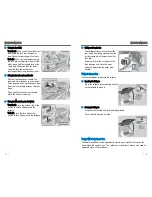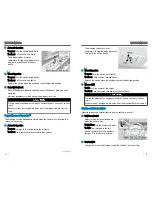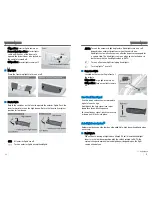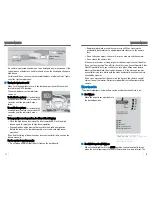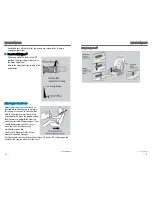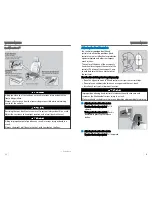
• A child seat or other object pressing against the rear of the seat-back.
• A rear passenger pushing or pulling on the back of the front passenger’s
seat.
• The front seat or seat-back is forced against an object on the seat or floor
behind it.
• An object placed under the front passenger’s seat.
If none of these conditions exist, have your vehicle checked by a dealer as
soon as possible.
The passenger airbag off indicator may come on and go off repeatedly if the
total weight on the seat is near the airbag cutoff threshold.
n
Airbag System Components
1. Two SRS (Supplemental Restraint System) front airbags. The driver’s
airbag is stored in the center of the steering wheel; the front passenger’s
airbag is stored in the dashboard. Both are marked SRS AIRBAG.
2. Two side airbags, one for the driver and one for a front passenger. The
airbags are stored in the outer edges of the seat-backs. Both are marked
SIDE AIRBAG.
3. Two side curtain airbags, one for each side of the vehicle. The airbags
are stored in the ceiling, above the side windows. The front and rear
pillars are marked SIDE CURTAIN AIRBAG.
SAFETY INFORMATION
12 |
4. An electronic control unit that, when the vehicle is on, continually
monitors information about the various impact sensors, seat and buckle
sensors, rollover sensor, airbag activators, seat belt tensioners, and
other vehicle information. During a crash event the unit can record such
information.
5. Automatic front seat belt tensioners. The driver’s and front passenger’s
seat belt buckles incorporate sensors that detect whether or not the
belts are fastened.
6. A driver’s seat position sensor. This sensor determines the optimal force
at which the airbag will deploy in a crash.
7. Weight sensors in the front passenger’s seat. The front passenger’s
airbag will be turned off if the weight on the seat is about 65 lbs (29 kg)
or less (the weight of an infant or small child).
8. Impact sensors that can detect a moderate-to-severe front or side
impact.
9. An indicator on the dashboard that alerts you that the front passenger’s
front airbag has been turned off.
10. An indicator on the instrument panel that alerts you to a possible
problem with the airbag system or seat belt tensioners.
11. Safing sensor.
12. A rollover sensor that can detect if your vehicle is about to roll over and
signal the control unit to deploy both side curtain airbags.
n
Airbag Care
You do not need to, and should not, perform any maintenance on or replace
any airbag system components yourself. However, you should have your
vehicle inspected by a dealer in the following situations:
When the airbags have deployed
If an airbag has inflated, the control unit and other related parts must be
replaced. Similarly, once an automatic seat belt tensioner has been
activated, it must be replaced.
When the vehicle has been in a moderate-to-severe collision
Even if the airbags did not inflate, have your dealer inspect the following:
the driver’s seat position sensor, weight sensors in the passenger’s seat,
front seat belt tensioners, and each seat belt that was worn during the
crash.
SAFETY INFORMATION
| 13




















